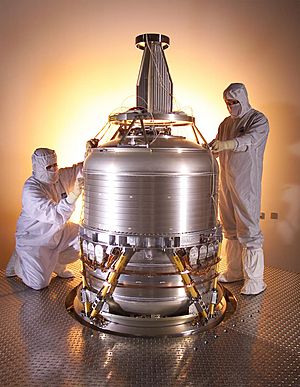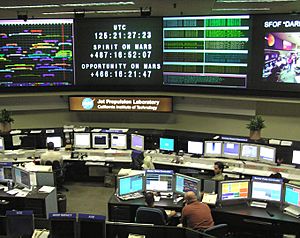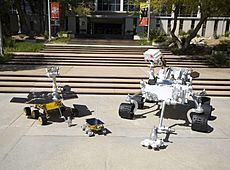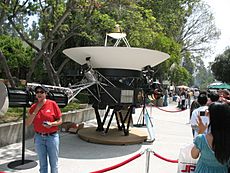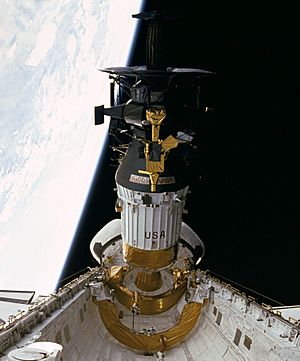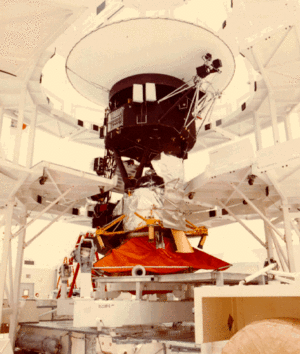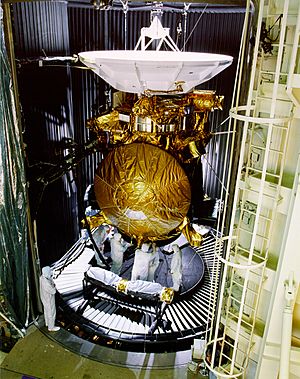Jet Propulsion Laboratory facts for kids
 |
|
 |
|
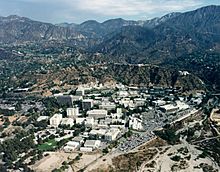 Aerial view of JPL |
|
| Agency overview | |
|---|---|
| Formed | October 31, 1936 |
| Jurisdiction | Federal government of the United States |
| Headquarters | 4800 Oak Grove Drive, Pasadena, California, U.S. 34°12′6.1″N 118°10′18″W / 34.201694°N 118.17167°W |
| Employees | > 15,000 |
| Agency executive |
|
| Parent agency | Managed for NASA by Caltech |
| Child agency |
|
The Jet Propulsion Laboratory (JPL) is a special research and development center. It is owned by NASA and managed by the California Institute of Technology (Caltech). JPL is located in Pasadena, California, United States.
JPL's main job is to build and operate robotic spacecraft that explore other planets. They also work on missions that study Earth from space and look at distant stars. JPL is also in charge of NASA's Deep Space Network, which is a system of giant antennas that talk to spacecraft far away.
Some of the exciting projects JPL is working on include:
- The Mars Science Laboratory mission, which has the Curiosity rover exploring Mars.
- The Mars Exploration Rover Opportunity (though its mission ended in 2019, it was a major success).
- The Mars Reconnaissance Orbiter, which studies Mars from orbit.
- The Dawn mission, which visited the dwarf planet Ceres and the asteroid Vesta.
- The Juno spacecraft, which is orbiting Jupiter.
- The NuSTAR X-ray telescope, which looks at X-rays from space.
- The SMAP Satellite, which measures soil moisture on Earth.
- The Spitzer Space Telescope, which observes the universe in infrared light.
JPL also manages the JPL Small-Body Database. This database keeps track of all known small objects in our Solar System.
Two important places at JPL, the Space Flight Operations Facility and the Twenty-Five-Foot Space Simulator, are recognized as National Historic Landmarks.
Contents
History of JPL
JPL started way back in 1936 at the California Institute of Technology (Caltech). Students there began doing rocket experiments in a place called the Arroyo Seco. They tested small, alcohol-fueled motors to learn how rockets work.
In 1939, the U.S. Army started giving money to this "GALCIT Rocket Project." By 1941, they showed the Army the first jet-assisted takeoff (JATO) rockets. These rockets helped planes take off faster. The project officially became the Jet Propulsion Laboratory in November 1943. It was an Army facility run by Caltech.
JPL's Early Work
During its time with the Army, JPL developed some of the first U.S. ballistic missiles, like the MGM-5 Corporal and MGM-29 Sergeant. These were important steps in rocket technology. They also worked on other rocket systems, like the Loki anti-aircraft missile.
JPL also tested rockets at different locations, including the White Sands Missile Range and Edwards Air Force Base. Interestingly, a lunar lander design from 1938-39 influenced the design of the Apollo Lunar Module that landed on the Moon in the 1960s.
Joining NASA
In December 1958, JPL joined NASA. It became NASA's main center for building spacecraft that explore other planets. JPL engineers designed and operated the Ranger and Surveyor missions. These missions went to the Moon and helped prepare the way for the Apollo missions that sent humans to the Moon.
JPL also led the way in exploring other planets with the Mariner missions. These spacecraft visited Venus, Mars, and Mercury. In 1998, JPL opened the Near-Earth Object Program Office for NASA. This office helps find asteroids that might come close to Earth. By 2013, they had found 95% of the large asteroids that cross Earth's orbit.
Women in Science at JPL
JPL was one of the first places to hire many female mathematicians. In the 1940s and 1950s, groups of women used mechanical calculators to figure out spacecraft paths. In 1961, Dana Ulery became the first female engineer to work alongside male engineers on the Ranger and Mariner missions.
JPL has won many awards for its work, including several from the Space Foundation for its contributions to space exploration and public outreach.
Where is JPL Located?
When JPL first started, it was next to a rocky riverbed called the Arroyo Seco in Pasadena. Even though many of JPL's buildings are now in a nearby city called La Cañada Flintridge, JPL still uses a Pasadena address for its mail. This is because JPL became famous as a Pasadena institution long before La Cañada Flintridge became a city in 1976.
Who Works at JPL?
About 6,000 full-time employees from Caltech work at JPL. Plus, there are usually a few thousand extra contractors working on different projects. NASA also has its own team of federal managers at JPL who oversee the work. You'll also find graduate students, college interns, and co-op students learning and working there.
Learning at JPL
The JPL Education Office helps teachers and students learn about NASA missions and science. They offer activities, resources, and chances to get involved. Their goal is to get students excited about careers in STEM (science, technology, engineering, and mathematics).
Internships and Fellowships
JPL offers amazing opportunities for high school, college, and graduate students. These include research, internships, and fellowships throughout the year. Students can work on projects in areas like robotics, planetary science, and aerospace engineering.
In 2013, Popular Science magazine named JPL one of "The 10 Most Awesome College Labs." They noted that about 100 students who intern at JPL are often offered permanent jobs after they graduate.
JPL also hosts the Planetary Science Summer School (PSSS). This is a week-long workshop for graduate students. They work in teams to design early mission concepts, just like real JPL engineers do.
Museum Alliance
In 2003, JPL created the NASA Museum Alliance. This group helps museums, planetariums, and other informal educators get materials and information about NASA missions. It started to help share news about the Mars rovers Spirit and Opportunity. Now, over 500 members get access to NASA displays, models, and educational workshops.
Educator Resource Center
The NASA/JPL Educator Resource Center provides free resources, materials, and workshops for teachers. These cover science, technology, engineering, and math topics related to NASA's missions and science.
Visiting JPL
JPL used to have an "Open House" once a year, usually in May or June. The public could tour the facilities and see live demonstrations of JPL's science and technology. Since 2016, they've changed it to "Ticket to Explore JPL," which still features the same exhibits but requires tickets and advance reservations.
Thousands of schoolchildren from Southern California and other places visit JPL every year.
JPL's Other Work
Besides its government work, JPL has also helped the movie and TV industries. They advise filmmakers on scientific accuracy for shows like Babylon 5.
JPL also works with the Department of Homeland Security Science and Technology Directorate. Together, they developed a search and rescue tool called FINDER. This tool helps first responders find people buried in rubble after a disaster. FINDER uses microwave radar to detect breathing and heartbeats.
JPL's Missions
JPL has played a big part in many important space missions. Here are some of them:
- Explorer program
- Ranger program
- Surveyor program
- Mariner program
- Pioneer 3 & 4
- Viking program
- Voyager program
- Magellan probe
- Galileo probe
- Wide Field and Planetary Camera 2 (for the Hubble Space Telescope)
- Deep Space 1 & 2
- Mars Global Surveyor
- Mars Climate Orbiter
- Cassini–Huygens (to Saturn)
- Stardust (collected comet dust)
- Mars Odyssey
- Mars Pathfinder
- Mars Exploration Rover Mission
- Spitzer Space Telescope
- Mars Reconnaissance Orbiter
- Gravity Recovery and Climate Experiment (GRACE)
- CloudSat
- Phoenix (spacecraft) (landed on Mars)
- Ocean Surface Topography Mission (OSTM/Jason-2)
- Orbiting Carbon Observatory
- Mars Science Laboratory (Curiosity rover)
- Wide-field Infrared Survey Explorer
- Shuttle Radar Topography Mission
See also
 In Spanish: Laboratorio de Propulsión a Reacción para niños
In Spanish: Laboratorio de Propulsión a Reacción para niños


